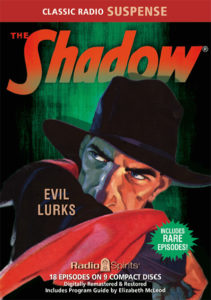
The Shadow, my favorite pulp hero, first appeared on radio on the CBS weekly Detective Story Magazine. That was 1930, and at that point, he was just the host/announcer, like the 1940s Whistler program. The Shadow appeared in the pulps in 1931 with the first of his 325 magazine stories, “The Living Shadow.” But the radio version of The Shadow that we all remember so well — that of Lamont Cranston and his power to cloud men’s minds so that they could not see him — didn’t appear until fall 1937 when Orson Welles portrayed the crime fighter. And for the next 17 years, The Shadow radio adventures could be heard at 5:30 p.m. Sundays on the Mutual Broadcasting System.
Today we still remember The Shadow, in large part, because of the recordings of those radio shows which have survived. Yet out of over 600 broadcasts between 1937 and 1954, just a little over 200 recordings survived for fans to enjoy today. Sadly, 400-some adventures of The Shadow can’t be heard by listeners. It is a matter of celebration, then, when new recordings are discovered. Well, break out the fireworks, folks. It’s time to celebrate. Eleven new adventures of The Shadow have been uncovered and are available right now!
RadioSpirits.com, which has legally licensed the rights to distribute the radio shows from copyright owner Conde Nast, has just released a new set of 18 Shadow radio shows on CD. And 11 of those are newly found, never heard since the original broadcasts. I purchased the set… snapped it up just as fast my fingers could type in the web address. I’ve listened to all the shows, and want to give you a brief rundown of each episode. I’m sure my bias shows… I love The Shadow… so keep that in mind as you read these micro-reviews.
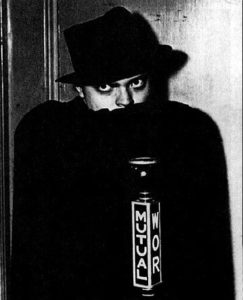
• “Cold Death” (12/19/37): A new episode featuring Orson Welles as The Shadow. It has Blue Coal commercials. Sadly, it’s probably the least exciting of the entire 52 episode Orson Welles series. It’s the Christmas episode, and there’s not much action or thrills. It’s a version of Charles Dickens’ A Christmas Carol with The Shadow playing the parts of the ghosts of Christmas past, present, and future for an Ebenezer Scrooge-type who owns a mill and the town housing its workers. The shacks are cheap, dilapidated constructions with no insulation. Workers are dying from the winter cold. That’s the “cold death” from the title.
Scriptwriters for The Shadow had trouble writing Christmas episodes featuring the invisible crimefighter. It was hard to write a warm and fuzzy, feel-good episode for Christmas that fit the blood-and-thunder style of The Shadow. By the late 1940s, they finally started getting it right, but it wasn’t easy. So this particular “newly found” episode of The Shadow is a bit of a let-down. But it helps fill in the gaps in the missing episodes of the Orson Welles run. So that’s nice.
• “Dead Men Talk” (09/24/39): This is not one of the new ones. Recordings have been around for years. But the audio quality is an upgrade from my previous copy. Still no commercials, though.
This one was the first broadcast of the 1939 season, the second season to feature Bill Johnstone in the starring role. The plot involves a missing racketeer, and a corrupt political boss. It’s a fun crime drama, but lacks much in the way of the eerie.
• “The Night Marauders” (10/01/39): Another episode that has previously circulated among collectors. But, as with the above program, this recording is definitely an upgrade. My old copy ran a bit fast, this one plays at the proper speed. Neither the old nor the new one have commercials.
Margo is awakened by hands at her throat… hands belonging to “Frankenstein‘s ugly brother,” as she describes him. It’s yet another in a series of jewel robberies, which The Shadow finally solves after a run-in with a gorilla. Not a bad story at all.
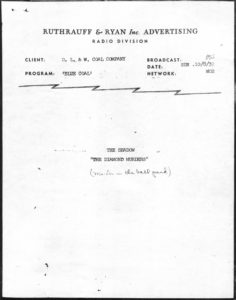
• “Murder in the Ball Park” (10/08/39): This is a newly discovered episode. No commercials. It was World Series season, so naturally the scriptwriters had to do a baseball-themed story. Originally, it was titled “The Diamond Murders,” referring to a baseball diamond, not a gemstone, but as you’ll hear, the announcer calls it “Murder in the Ball Park.” And that makes it official, for me.
Pitchers are being murdered, and it’s up to The Shadow to solve the mystery. The killer turns out to be the hunchbacked ball boy. Why is it that hunchbacks are always either evil assistants or killers? Boy, they sure got a bad rap back in those days. Dwarfs, too. But I guess radio was about stereotypes.
• “Village of Doom” (10/15/39): This is a newly discovered episode. No commericlals. It’s a good one! People in a small town are dying, mysteriously. The Shadow must take a hand and discover the source of the plague.
The killing of an infant is something shunned even in today’s more liberal television scripts, but it was seemingly okay in this Shadow tale.
• “The Ghost of Caleb Mackenzie” (01/26/41): Not a new one, a recording has been around for quite a while. Still, it’s fun to hear again in much better sound. It has Blue Coal commercials.
It was a dark and stormy night. Ah, a classic opening, and murder is in the offing. It’s one of those old dark house mysteries that The Shadow so often encountered. Uncle Caleb is killed and the search is on for his will. Margo, friend of the family, is in peril, and The Shadow comes to the rescue!
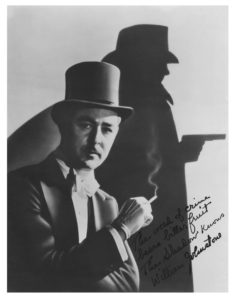
• “The Dragon’s Tongue Murders” (10/12/41): This is a newly discovered episode. It has Blue Coal commericlals. In the magazine series of The Shadow, readers always looked forward to a new Chinatown tale. They were considered some of the best Shadow tales. But on radio, the Chinatown tales were few and far between. This is one of those rare ones.
Some pretty gruesome murders in this story… electrocution… death by fire. And a trip to Chinatown, to boot. The solution involves a disguise that probably worked better on radio than it would have on TV or the movies. In your mind, you could imagine it; but had you seen it, you probably wouldn’t be fooled. Ignoring that weak spot, this is a top-notch Shadow mystery.
• “The Hoodoo Ship” (10/19/41): Not a new one, but a good one nonetheless. Much nicer sound quality. Blue Coal commercials. An old slaver ship is reputed to be haunted. But The Shadow proves otherwise. Love those sound effects!
• “The Devil’s Hour” (10/26/41): This is a newly discovered episode. It has Blue Coal commercials. The Shadow radio series always had a special script saved up for Halloween. And this is the one for 1941. You’ll like it.
The melancholy sound of a ram’s horn… The Devil‘s horn! The Devil himself is conjured up by witchcraft, or so the country folk believe. And Lamont Cranston is given one hour to find the truth.
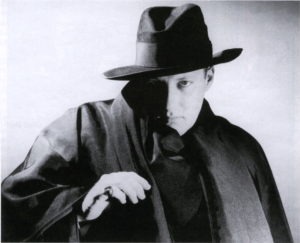
• “The Organ Played at Midnight” (11/09/41): This is a newly discovered episode. It has Blue Coal commericials. I found the plot a little confusing, but maybe it was just me. But it’s still a joy to hear a new episode.
Surgeons are being killed, and their right arms are removed. Turns out a mad doctor is amputating the arms of his colleagues, and The Shadow must stop him. Oh, yeah, and there’s an organ that plays at midnight. Say, what? I’m confused!
• “Death Imported” (12/21/41): This is a newly discovered episode, and one of best on this CD set. It has Blue Coal commercials. A giant hulking assistant to an escaped killer throws victims into a pit of hungry crocodiles. Wild and crazy story. The Shadow at his best. Boy, the sound effects man must have had a heyday with this one!
• “Death Pulls the Strings” (01/04/42): This is a newly discovered episode. It has Blue Coal commercials. And it’s one of those over-the-top plots that Shadow fans relish.
Life-size marionettes turn out to be corpses. And as they begin to decompose, the mad puppeteer must replace them with fresh dead bodies. Let’s say it all together, now: “Yyyeeewwwww!”
• “The Drums of Doom” (01/11/42): This is a newly discovered episode. It has Blue Coal commercials. Pretty good… not great, but pretty good.
Has Judge Cole come back from the grave? People are dying, hanged from the gallows hidden in a secret room, and it’s Margo’s turn next! Call The Shadow!
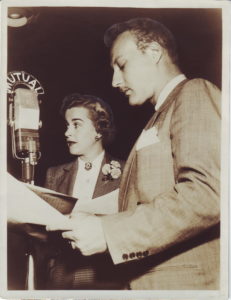
• “The Thing in the Swamp” (01/18/42): This is a newly discovered episode. It has Blue Coal commercials. I really liked this one, about a swamp monster. The Shadow is wounded because, although the bad guys can’t see The Shadow, they can see his wake as he swims in the swamp. Shoot the water! Shoot the water! We also get to visit a radio station as part of this mystery.
• “Dead Man’s Revenge” (01/25/42): This is a newly discovered episode. It has Blue Coal commercials. This is one of those “ghost in the theatre” shows. Not bad, although it’s not too hard to figure out who’s impersonating the ghost.
• “Drums of Doom” (03/19/44): This is not a new one, but an upgrade to my previous copy. It has Blue Coal commericials. Don’t confuse this episode with the similarly titled one above. Except for a single word, “the,” the title is the same. The plot, however, is completely different. Just a case of accidental duplication of titles.
This story, as well as the following two, star Bret Morrison as The Shadow.
The plot involves a dancer who is plagued by the sound of voodoo drums. Someone is trying to kill her… or trying to drive her mad. Good story with typical Shadow weirdness.
• “Death in a Minor Key” (06/02/46): A recording of this episode has existed in the hands of collectors for some time. It has public service announcements, as did the previously existing recording
The script was one reused from a 1940 broadcast, and involves death by snake bite. In 1940, Bill Johnstone was The Shadow. In this one, Bret Morrison takes the role. But the story is the same.
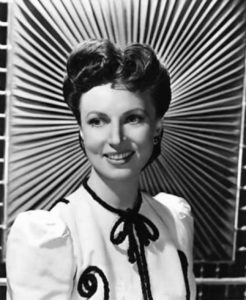
• “Gang Doctor” (11/24/46): Another existing recording, but the one on this CD is a nicer quality version. This one has Carey Salt commercials, as did the previously existing recording. The new version even has a needle repeat at the same place as the old version. Seems they just took the old recording and did some digital cleaning on it… but ignored the needle repeat at the 15-second mark.
As the title indicates, this is primarily a crime drama. Not much of the “supernatural” element which made so many of The Shadow broadcasts unique. Plastic surgery was new at the time and became the subject of many movie and radio plots. This is one of those.
In closing…
So, there you have it. Eighteen Shadow broadcasts released in a single set of CDs by RadioSpirits.com — and 11 of them, newly found. To me, and other fans of The Shadow, that makes this a treasure trove of new, exciting radio dramas. After listening to the existing Shadow episodes over and over, it’s quite exciting to hear some “new” shows for a change. The Shadow knows!

I love The Shadow too, but never got into the radio shows too seriously. I loved the Jack Benny and Philip Marlowe radio series. While later series that were still running strong in the 1950s seem to proliferate on late night radio (because of the availability of recording equipment and the better special sound effects) I’ve always found older series like “Cinnamon Bear” and “Omar Wizard of Persia” to be more fun and imaginative.
It’s cool to know that “lost” episodes are coming to light, even if it’s unlikely that I’ll listen to them.
Maybe it’s because I started listening to The Shadow around age 12, but didn’t start reading The Shadow until many years later. I wonder what would have happened if that had been switched around.
My favorites in radio listening are the thrillers… I Love A Mystery, Inner Sanctum, etc. And The Shadow fits right in with those.
John- Great review as always. I also enjoy the transcriptions that include the original commercials.
Do you know if there any background story on how/where the lost episodes were found? Was it a find in one collection or each one found in a different location? Etc. (Or, maybe, RS doesn’t reveal their sources…?)
Thanks, as always, for sharing you review with us.
I’m curious about the source of the new recordings, as well. Often, word circulates among OTR fans well in advance of an official CD release. Perhaps years in advance. But in this case, I was caught off guard. I hadn’t heard a thing.
It’s interesting to speculate. I might guess that “Murder in the Ballpark” and “Village of Doom” were found together. That’s because they are dated close together, and have no commercials. That indicates they came from discs Charles Michelson syndicated in the late 1930s-early 1940s to markets that didn’t carry the network version. I might also guess that the single Orson Welles show, “Cold Death” was found separately, since it’s a bit of an outlier among the rest. But that’s all speculation. I haven’t heard anything.
If anyone knows (other than The Shadow, of course) I hope they’ll take the time to leave a quick reply here. We’d all appreciate it.